Columbia Pictures (July 29, 1981), Columbia TriStar Home Video (November 23, 1999), single disc, 90 mins plus supplements, 1.85:1 anamorphic widescreen, Dolby Digital 5.1, Rated R, Retail: $27.95
Storyboard:
Several science fiction vignettes form a rough story of the shape that evil takes in the galaxy, based on the works of top comics creators.
The Sweatbox Review:
This film defines “guilty pleasure”.

It doesn’t aspire to be deep, meaningful, or touching. It’s all about putting boobs & rock and roll into a cartoon, baby, and it makes no apologies for it. If you’re not male and over twelve, chances are you won’t dig it. For the intended audience, however, this is a cult classic that has been treated extremely well by an absolutely rockin’ DVD.
Publisher National Lampoon had had success with its 1978 Animal House movie produced by Ivan Reitman (later to do Ghostbusters, Kindergarten Cop, and Space Jam). This made them eager to exploit one of their publications in order to make a new movie. They contacted Reitman about basing a movie on Heavy Metal, a graphic story magazine that appealed to the young adult male market. Heavy Metal was the licensed American version of a French magazine named Metal Hurlant, and its stories tended to be oriented towards science fiction mixed with eroticism. The idea of making an animated film based on those types of stories was, at the time, both revolutionary and brilliant. The capper was the addition of hard rock and heavy metal music, with contributions coming from the likes of Journey, Nazareth, Stevie Nicks, Black Sabbath, and Cheap Trick. A total of 17 tracks from thirteen artists were eventually recorded for the soundtrack.
An enthusiastic Reitman and some others went about the task of selecting stories to adapt, knowing that they were basically looking for unapologetic male fantasies. There was a wealth of material, but it turned out to be more difficult than expected to secure the rights to some stories, partially due to a competing project in France. This led Reitman to decide to develop original stories as well, inspired by the Heavy Metal aesthetic. The creative team also had to figure out a way of linking the stories together into a somewhat cohesive narrative.
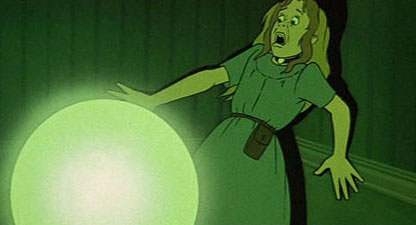
The linking device they decided on was only partially successful, but it was enough. The moviemakers created the notion of the “Loc-Nar”, a green orb that embodies pure Evil. The orb is basically the film’s narrator, telling tales to a girl about how its evil influence has caused the downfall of individuals and civilizations. This means that the orb has to make an appearance in each story, and it’s often a forced appearance. The documentary on the disc reveals that even the writers and directors couldn’t get straight for themselves what the Loc-Nar could do or how it should be used in each story. That’s not really important, though. What is important is that the stories contain terrific visuals, great music, and, uh… oh, I’ll just say it: lots of nekkid wimmen. Here’s a rundown of the stories:
Soft Landing opens the movie, and is basically a title sequence. It combines some unique animation techniques as well as photography to create a look unlike anything else in the movie. If you haven’t seen the movie before, I want you to be surprised by exactly what happens, but this sequence shows an Earth re-entry by an astronaut unlike anything you’ve seen before.
Soft Landing leads directly into Grimaldi 1, which introduces us better to the astronaut (Grimaldi, according to Carl Macek), his daughter, and the Loc-Nar, which describes itself as “the sum of all evils”.

The Loc-Nar tries to intimidate the girl by stories of its evilness, starting with Harry Canyon. This sequence is a favorite of many, an original film noir piece about a New York cabbie. An ancient artifact, actually the Loc-Nar, has been discovered and is on exhibit at the Metropolitan Museum, but people representing certain “Venusian interests” kill the man who found it. The man’s daughter is rescued by Harry, who gets rewarded in a manner that males in the audience will appreciate. What follows is a hard-edged story of greed and just desserts. This is likely a favorite due to the relative seriousness in which it is told. The animation, drawing, and voice acting is also at least as strong as anything else in the movie.
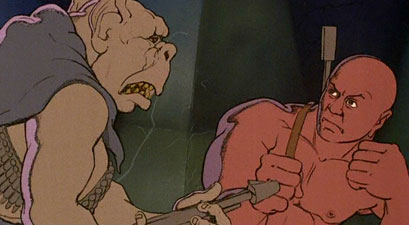
After another Grimaldi bridging sequence (Grimaldi 2), we get the first adapted story— that of Richard Corben’s Den. Den is an Earth teenager who is transformed by unclear means (but involving the found Loc-Nar) into a muscular, well-endowed (suggested, not shown) hero of another world. This hero is voiced by John Candy, which gives the whole thing a way different vibe. I would have thought the choice of Candy unconventional, but he does provide Den with an inner voice that reveals more of the boy within. Den stops a sacrifice of a naked maiden by naked priestesses in the presence of the Loc-Nar. After being “rewarded”, Den becomes further involved in a plot involving two different factions that want the power of the Loc-Nar. (He also gets rewarded without having to do anything, another male fantasy.) This is a good sequence, mainly in a “Hey, Den got lucky again” kind of way, but the artists obviously were not up to reproducing Corben’s artwork. The animation is often awkward, with anatomy that is clumsily drawn. The backgrounds have a nice Corben-esque quality, though, reminiscent of his colorfully high-contrast airbrushed artwork.
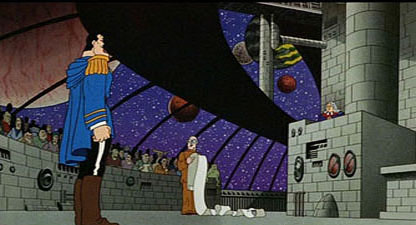
The Loc-Nar then finds itself involved in the story of Berni Wrightson’s Captain Sternn. Sternn is a contemptible scumbag who is nevertheless fairly charming. During his trial for assorted crimes, we meet Hanover Fiste, the new possessor of the Loc-Nar. The artists here do much better at reproducing the look of the original published story, although there is still a rushed quality to it in places.
Captain Sternn segues into B-17/Gremlins, which features an aerial battle in World War II. The Loc-Nar follows a nearly destroyed plane and turns the dead crew into zombies. (This movie really has it all!) The ending of this sequence gets a neat Twilight Zone-y twist, but for some reason I have always found this one the least memorable. I guess I’m just not a big fan of the evil dead genre.
Another segue leads us to Washington, D.C. for So Beautiful and So Dangerous, a sequence loosely based on a serialized story from the magazine. This one starts out in Washington, D.C., where a group of military and political men are discussing something about mutations that have been occurring (the plot here is not really fully developed). Suddenly, a huge spaceship appears and kidnaps a man and the meeting’s stenographer, perhaps because she is wearing a Loc-Nar pendant. It’s all just a way to get to the real story, which examines robot love. There’s also a drug reference. By now, you all realize that this movie is for older viewers, right? (Notice that I didn’t use the term “mature viewers”.) This is likely the most slickly and colorfully animated sequence of the bunch.

Grimaldi 3 gives more hints as to why the orb has singled out this girl to tell its stories. The Loc-Nar then launches into its final tale, that of Taarna. This one was an original story, although heavily influenced by visuals from another magazine story. The orb crashes onto an alien world, having become big enough to occupy much of a mountaintop. It converts curious onlookers into an evil army, which proceeds to attack a nearby city. The scientist-philosophers that rule the city call on the last survivor of a warrior race, Taarna, to save them. (It is the statuesque Taarna who is featured in the famous movie poster and the cover of the video/laserdisc/DVD.) This sequence features some of the most intriguing and ambitious animation, aided by rotoscoping live-action footage. Two examples are when Taarna flies over the countryside while the details of the rock formations are drawn in perspective frame by frame, and a sensual reverse-striptease. The animation nut in me appreciates this story the most, although the pacing is maybe the slowest of them all, seeming longer than its twelve minutes. Notably, this sequence manages to be the sexiest in the movie without having any sex in it.
The wrap-up comes with Grimaldi 4, where the filmmakers bring things to a satisfying but, in retrospect, confusing manner. This, like much of the film, relies on a cool idea that is not fully developed or explained. However, in case you haven’t been paying attention this far, that really isn’t the point. From beginning to end, Heavy Metal is about ideas, images, and sound. It ain’t Hamlet.
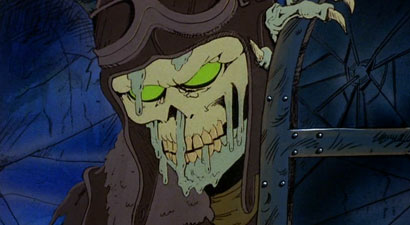
I haven’t mentioned the gore yet. There is likely not enough of it to appease fans of gore, but there is enough to turn off those who are very squeamish. Some spilled intestines here, some beheadings there. Not too big of a deal, but consider yourself warned. I’m sure most will find it quite mild.
The animation was farmed out to several small studios in Canada (in fact, it is technically a Canadian film since it was financed there), the U.S., and Europe. Each sequence also had its own director. The result is that each sequence has a totally different look, appropriate for an anthology. It also means, however, that the quality of the animation is inconsistent. These smaller operations weren’t Disney, after all, although I know of one fellow from my hometown who worked on both Heavy Metal and Toy Story, so there is definitely some talent on display here. Some of the animation is actually very good, and animation buffs will enjoy the variety of techniques on display. Still, the rushed nature of the production does show in spots, as does the uneven nature of the artistic talents involved.
It took a long time for this movie to come to home video, as it took years to sort out the music rights. Instead, fans had to go to countless midnight shows at local theaters that showed such movies (along with Rocky Horror Picture Show and the like), or suffer through bad bootlegs. It got a proper re-release in 1997 to promote the video, and when the VHS was released, it sold over a million copies in the U.S. and Canada. The laserdisc was also a winner (although it was unfortunately found to be prone to dreaded “laser rot”). This DVD, however, is the best presentation yet, and jammed with terrific features as well.
Is This Thing Loaded?
There is plenty here for animation fans to enjoy. In fact, I’m sure that if the disc were just being released in today’s market, this would be stretched into a two-disc set.
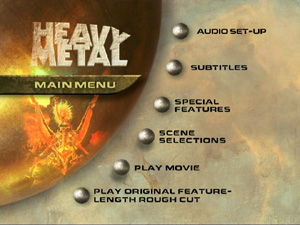
The coolest feature is accessible through the main menu. We are treated by an entire alternate version of the movie, the Original Feature-Length Rough Cut, basically a work-in-progress version. This is an early cut of the film, with rough animation, layouts, and even live-action footage that was later to be rotoscoped. The sequencing of the stories is also different from what was later decided. Additionally, there is an excellent optional running commentary for this version by Carl Macek.
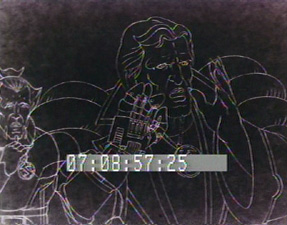
Speaking of which, Macek also provides a reading of his “making-of” book of the film. This plays with the feature itself, although it is not screen-specific. If you turn off the picture and think of it more of an audio book, then you will find it to be very informative.
Moving to the actual Bonus Features menu, the fun starts with two deleted scenes. Neverwhere Land was intended to be a bridge between “Captain Sternn” and “B-17”. Animator Cornelius Cole’s work is more drawn than animated, but it is still a tour de force look at evil through the ages, leading to the war seen in “B-17”. This sequence was unlike anything else in the movie, but was regrettably cut for issues of time as well as pacing. Secondly, the Alternate Framing Sequence is shown only partially completed. It involved using the astronaut, the little girl, and a carousel that utilized figures from the stories. It can be played with or without audio commentary. Interesting, but I can see how it did not suit the tone of the rest of the film.
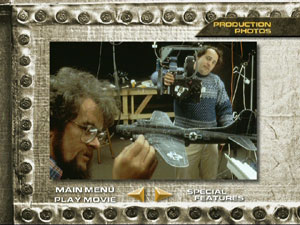
Artwork Of Heavy Metal gives us a Pencil Portfolio, Conceptual Art, a Single Cel Portfolio, and a Layered Cel Portfolio. Production Photos focuses on the live action planning and rotoscoping for the B-17 plane, the Taarna actress, and the planetscape which Taarna flew over.
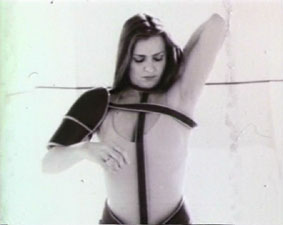
Imagining Heavy Metal is a 35 minute documentary that gives the whole story of the movie’s creation. Several people are interviewed, including producer Reitman, then-new Heavy Metal publisher Kevin Eastman, and some of the directors and other creative people from the movie. The documentary also features a look at how the special effects (namely the rotoscoped footage) were achieved, and discusses the choice to use Toronto Second City performers in voice roles. This is informative and well done.
Lastly, a Heavy Metal Cover Gallery provides every single magazine cover image from 1977 through 1999.
Case Study:
Standard keepcase, with a four-page booklet containing liner notes and chapter list. Basic, but nice.
Ink And Paint:
As the movie starts, the image is marred by numerous splotches and dirt marks, but that quickly disappears and Heavy Metal fans are treated to a usually sparkling 1.85:1 anamorphic transfer. I say “usually”, because the blemishes do re-appear from time to time. This seems to be mainly a source material issue, as the transfer itself is wonderful. The picture is consistently clear, and free of compression artifacts. Some parts explode with color, and yet there is no “bleeding”. Considering the low budget nature of this movie, it looks fantastic on this DVD.

Scratch Tracks:
As a shuttle zooms across both the television screen and your home theater surrounds in the opening minutes of “Soft Landing”, you are quickly served notice that you are about to be treated with a most satisfying sonic experience. As if the rock soundtrack wasn’t great enough, the remastered 5.1 Dolby Digital sound is bursting with life and frequently utilizes every speaker. Another great example is in the So Beautiful and So Dangerous story, where lots of things are zipping through space. The rear surrounds are used in an interesting fashion at times, such as when the narration in Taarna comes solely from the rears, giving a slightly spooky effect. You can tell that a lot of thought and effort went into making this something special. If I had to nitpick, I’d say that there were missed opportunities to pump up the low end during explosions or with some of the music, but really this is a very fine re-mix.

There is also a surprisingly good, but not as enveloping, Dolby Surround mix. The 5.1 mix definitely is more powerful and has the better audio effects.
Subtitles are provided in English, Spanish and Portuguese.
Final Cut:
Bottom line: So long as you’re not easily offended, Heavy Metal is an intriguing cult classic that demands to be viewed at least once. I’ve watched it a few times now, and like it more each time. The stories, aside from being male fantasies of power and sex, offer a nice range of science fiction themes and a good assortment of animation styles. For those that like something besides singing forest creatures in their animation, this is a great movie to check out.
There is also a Superbit version out there, without any of the special features. I haven’t watched it, but I cannot imagine that the video and audio are sufficiently improved to justify missing out on all the wonderful bonus features of the original DVD. Due to the standout remastering work and outstanding depth of special features, I consider this to be one of THE premiere animation DVD’s on the market!
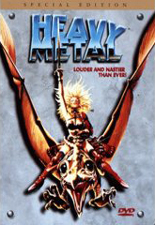 | ||
 |







